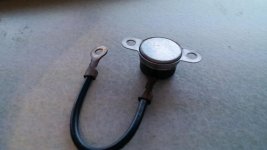eeguru
Veteran Member
I'm trying to refit a 3B2/1000-80's power supply with a custom bridge board to an ATX supply. The last signal I need to deal with is the thermal overload sense. It's a single wire running to one terminal of the pictured device below. The black lead on the other terminal is tied to chassis ground via one of the two mounting screws. When I check resistance across the terminals, I see a dead short. When I try and pass current through it limited by a resistor, the resistor is dissipating all the potential. So it doesn't behave like a thermal sense resistor or diode. Does anyone have any ideas what it is or if it might be defective?


